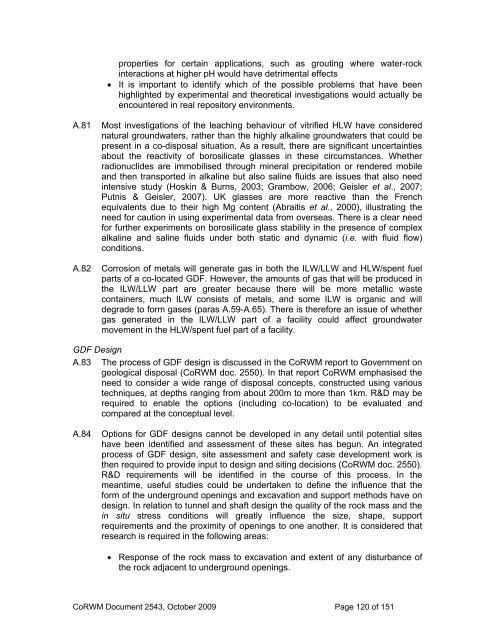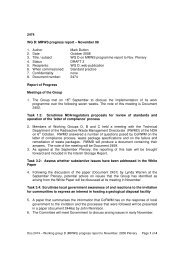2009 Report to Government on National Research and
2009 Report to Government on National Research and
2009 Report to Government on National Research and
- TAGS
- corwm.decc.gov.uk
Create successful ePaper yourself
Turn your PDF publications into a flip-book with our unique Google optimized e-Paper software.
properties for certain applicati<strong>on</strong>s, such as grouting where water-rock<br />
interacti<strong>on</strong>s at higher pH would have detrimental effects<br />
• It is important <str<strong>on</strong>g>to</str<strong>on</strong>g> identify which of the possible problems that have been<br />
highlighted by experimental <strong>and</strong> theoretical investigati<strong>on</strong>s would actually be<br />
encountered in real reposi<str<strong>on</strong>g>to</str<strong>on</strong>g>ry envir<strong>on</strong>ments.<br />
A.81 Most investigati<strong>on</strong>s of the leaching behaviour of vitrified HLW have c<strong>on</strong>sidered<br />
natural groundwaters, rather than the highly alkaline groundwaters that could be<br />
present in a co-disposal situati<strong>on</strong>. As a result, there are significant uncertainties<br />
about the reactivity of borosilicate glasses in these circumstances. Whether<br />
radi<strong>on</strong>uclides are immobilised through mineral precipitati<strong>on</strong> or rendered mobile<br />
<strong>and</strong> then transported in alkaline but also saline fluids are issues that also need<br />
intensive study (Hoskin & Burns, 2003; Grambow, 2006; Geisler et al., 2007;<br />
Putnis & Geisler, 2007). UK glasses are more reactive than the French<br />
equivalents due <str<strong>on</strong>g>to</str<strong>on</strong>g> their high Mg c<strong>on</strong>tent (Abraitis et al., 2000), illustrating the<br />
need for cauti<strong>on</strong> in using experimental data from overseas. There is a clear need<br />
for further experiments <strong>on</strong> borosilicate glass stability in the presence of complex<br />
alkaline <strong>and</strong> saline fluids under both static <strong>and</strong> dynamic (i.e. with fluid flow)<br />
c<strong>on</strong>diti<strong>on</strong>s.<br />
A.82 Corrosi<strong>on</strong> of metals will generate gas in both the ILW/LLW <strong>and</strong> HLW/spent fuel<br />
parts of a co-located GDF. However, the amounts of gas that will be produced in<br />
the ILW/LLW part are greater because there will be more metallic waste<br />
c<strong>on</strong>tainers, much ILW c<strong>on</strong>sists of metals, <strong>and</strong> some ILW is organic <strong>and</strong> will<br />
degrade <str<strong>on</strong>g>to</str<strong>on</strong>g> form gases (paras A.59-A.65). There is therefore an issue of whether<br />
gas generated in the ILW/LLW part of a facility could affect groundwater<br />
movement in the HLW/spent fuel part of a facility.<br />
GDF Design<br />
A.83 The process of GDF design is discussed in the CoRWM report <str<strong>on</strong>g>to</str<strong>on</strong>g> <str<strong>on</strong>g>Government</str<strong>on</strong>g> <strong>on</strong><br />
geological disposal (CoRWM doc. 2550). In that report CoRWM emphasised the<br />
need <str<strong>on</strong>g>to</str<strong>on</strong>g> c<strong>on</strong>sider a wide range of disposal c<strong>on</strong>cepts, c<strong>on</strong>structed using various<br />
techniques, at depths ranging from about 200m <str<strong>on</strong>g>to</str<strong>on</strong>g> more than 1km. R&D may be<br />
required <str<strong>on</strong>g>to</str<strong>on</strong>g> enable the opti<strong>on</strong>s (including co-locati<strong>on</strong>) <str<strong>on</strong>g>to</str<strong>on</strong>g> be evaluated <strong>and</strong><br />
compared at the c<strong>on</strong>ceptual level.<br />
A.84 Opti<strong>on</strong>s for GDF designs cannot be developed in any detail until potential sites<br />
have been identified <strong>and</strong> assessment of these sites has begun. An integrated<br />
process of GDF design, site assessment <strong>and</strong> safety case development work is<br />
then required <str<strong>on</strong>g>to</str<strong>on</strong>g> provide input <str<strong>on</strong>g>to</str<strong>on</strong>g> design <strong>and</strong> siting decisi<strong>on</strong>s (CoRWM doc. 2550).<br />
R&D requirements will be identified in the course of this process. In the<br />
meantime, useful studies could be undertaken <str<strong>on</strong>g>to</str<strong>on</strong>g> define the influence that the<br />
form of the underground openings <strong>and</strong> excavati<strong>on</strong> <strong>and</strong> support methods have <strong>on</strong><br />
design. In relati<strong>on</strong> <str<strong>on</strong>g>to</str<strong>on</strong>g> tunnel <strong>and</strong> shaft design the quality of the rock mass <strong>and</strong> the<br />
in situ stress c<strong>on</strong>diti<strong>on</strong>s will greatly influence the size, shape, support<br />
requirements <strong>and</strong> the proximity of openings <str<strong>on</strong>g>to</str<strong>on</strong>g> <strong>on</strong>e another. It is c<strong>on</strong>sidered that<br />
research is required in the following areas:<br />
• Resp<strong>on</strong>se of the rock mass <str<strong>on</strong>g>to</str<strong>on</strong>g> excavati<strong>on</strong> <strong>and</strong> extent of any disturbance of<br />
the rock adjacent <str<strong>on</strong>g>to</str<strong>on</strong>g> underground openings.<br />
CoRWM Document 2543, Oc<str<strong>on</strong>g>to</str<strong>on</strong>g>ber <str<strong>on</strong>g>2009</str<strong>on</strong>g> Page 120 of 151



